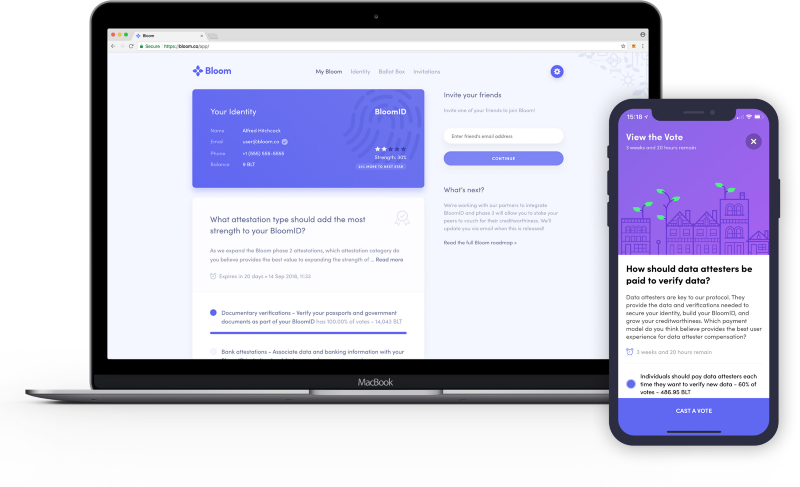The Results Are In — Bloom’s September 2018 Community Polls

Voting has concluded for the most recent round of community polls with over 250k BLT staked by voters!
These questions were not only the most in depth questions we’ve published so far, but also marked a major UX milestone. Bloom users were able to vote in the polls without paying any transaction fees!
Voting is critical for users. These polls help us determine how to implement the core capabilities of the Bloom protocol while considering the trade-offs between security, data integrity and user experience.
Read on for the official poll results.
Question #1: Should a failed attestation be visible on the blockchain?
First place (83%): Failed attestations should be published on chain but with no information linking it to a specific BloomID
Second place (12%): Failed attestations should be forgotten and nothing should be written on-chain
Third place (5%): Failed attestations should be published on-chain and associated with a BloomID
Commentary
Data attesters verify personal data provided by Bloom users and associate the verified data with a BloomID on the blockchain. Data attesters will refuse to attest to data they believe to be incomplete, inaccurate or fraudulent. However, data verifiers are not perfect. If a failed attestation is permanently associated with a BloomID it could significantly impact that user’s reputation. On the other hand, failed attestations potentially carry valuable information. They provide details about how often an attester passes or fails certain individuals. The winning answer aligns with our internal conclusions and fits well with how we have designed the smart contracts so far. If an attester refuses to verify a trait about a user, they can contest the attestation. No information about the subject of the contested attestation is revealed, but the attester still receives payment for their completed work.
Question #2: How should data attesters be paid to verify data?
First place (95%): Individuals should pay data attesters each time they want to verify new data
Second place (4%): Lenders or other 3rd parties should pay data attesters to verify the data of each client
Third place (1%): Bloom should pay data attesters directly and recover the cost from lenders or other 3rd parties
Fourth place (0%): Bloom should pay data attesters directly and recover the cost from BloomID users
Commentary
Payment is directly coupled to submitting an attestation on the blockchain. When an attester submits an attestation they unlock BLT which was locked in escrow by an attestation requester. Our protocol is flexible enough that any of these payment models are possible using the deployed smart contracts. Since the beginning, Bloom has been paying all of the costs of completing attestations for our users. Users are welcome to use our smart contracts directly to request and pay for individual attestations. However, for the time being, we will likely continue to absorb most of these costs.
Question #3: Which of these is the most compelling alternative use case for BloomID?
First place (85%): Verified education and employment history
Second place (10%): On chain records of family relationships
Third place (4%): Unified system for travel ‘fast lanes’
Fourth place (1%): Verified identities for dating applications
Commentary
A portable, verified, digital identity opens up a world of possibilities for users beyond credit. Recently at the Bloom team summit in San Francisco we brainstormed some alternative use cases for BloomID. The top ideas from this session were used as choices for this question. We had fun discussing the positive and negative implications of introducing the concepts of attestations in new spaces, especially the dating application. How do you attest trait’s about someone’s personality without turning into a Black Mirror episode?

What attestation type should add the most strength to your BloomID?
First place (95%): Document verification — Verify your passports and government documents as part of your BloomID
Second place (4%): Bank attestations — Associate data and banking information with your BloomID including bank balance and payment records
Third place (0.5%): Social media attestations — Link multiple accounts to your BloomID
Fourth place (0.5%): Utility Bill Data — Associate repayment data from your utility company with your BloomID
Commentary
Bloom is constantly working on adding new attestation types to BloomID. Completing each attestation adds to your profile strength corresponding to the amount of assurance it adds that you are who you claim to be. The winning answer aligns with the current breakdown we implemented in BloomID. ID Document attestations (available now!) add 20% strength to your profile whereas social media accounts add just 5%. Bank and utility bill attestations are coming soon!

What is the optimal way of handling BloomID device-based authentication
First place (86%): Mobile device as the primary means of authentication
Second place (14%): Any of your devices can be used to link an additional device
Commentary
Our vision is for the mobile app to be the center of your BloomID experience. Your phone will hold the keys to all of your encrypted personal information. Bloom will enable you to verify this information with our network of data attesters. Any time a third party requests access to your personal information you will authorize releasing the data via the mobile app.
What should happen if a user loses control of their BloomID?
First place (82%): All attestions become invalid and the user starts over with a new BloomID
Second place (18%): The user appoints trusted people who can vote to recover their BloomID or wipe it
Third place (0%): The user selects which attestations should be invalid based on what they believe was compromised
Commentary
Bloom gives users unprecedented control over their personal information. Users hold the only keys to a centralized repository of their verified personal information. However, users now also have the responsibility to safeguard their device and data backups. If someone’s device becomes compromised, so do the keys to their verified personal information. The safest way to handle this situation is to simply flag the BloomID as compromised and prevent a malicious actor from using the completed attestations to steal a user’s identity. The challenge still exists how to tell for certain if a BloomID has been compromised.
Learn More: Take Back Control of Your Data Today
Thank you for your input on these latest polls! A lot of the value we get from the community polls comes from the debate in our Slack and Telegram channels.
Join us and share your thoughts!

